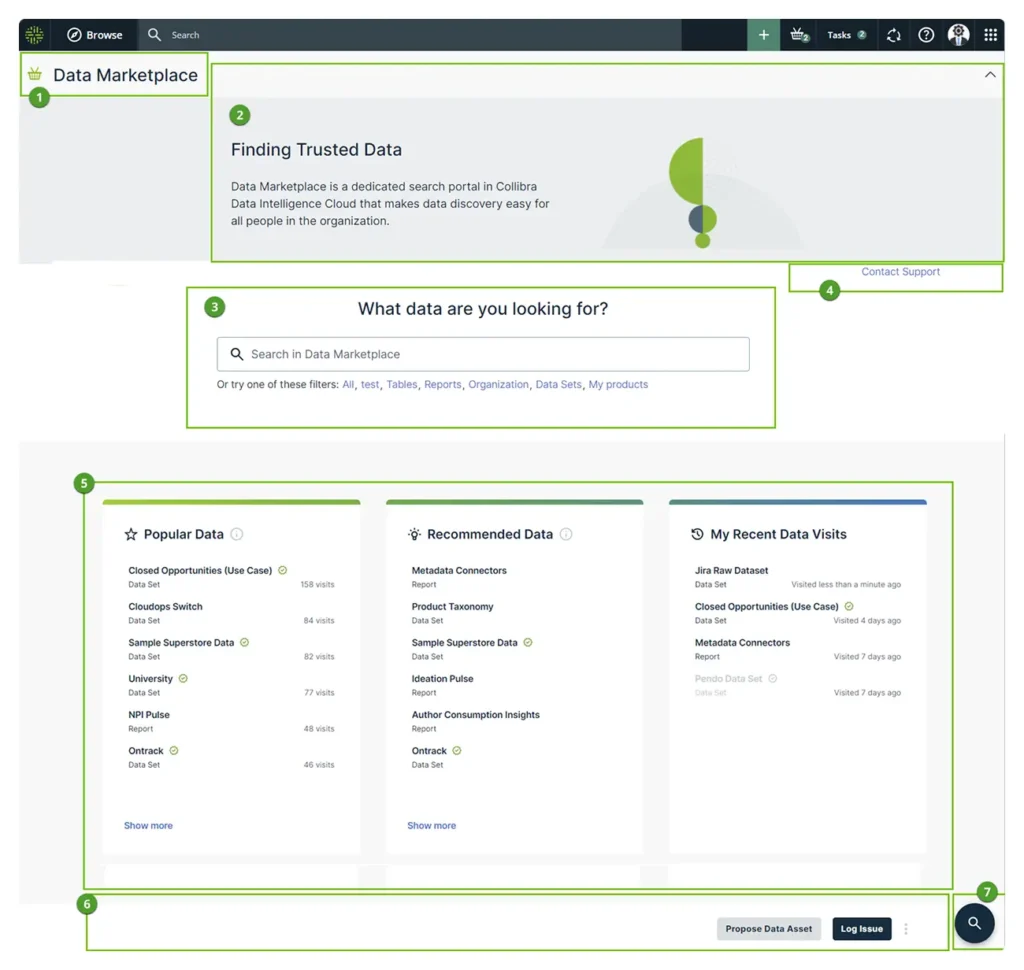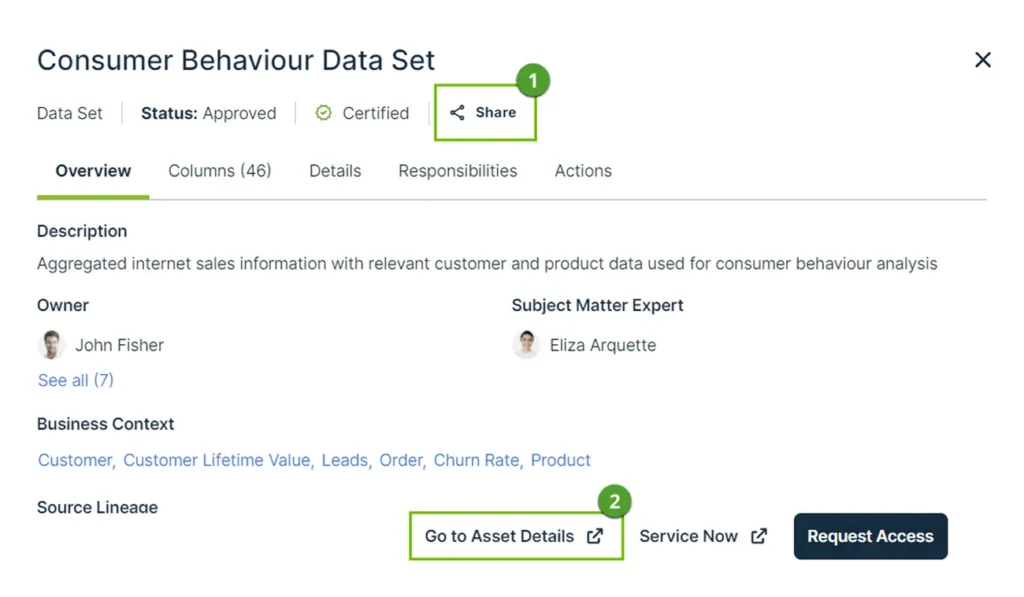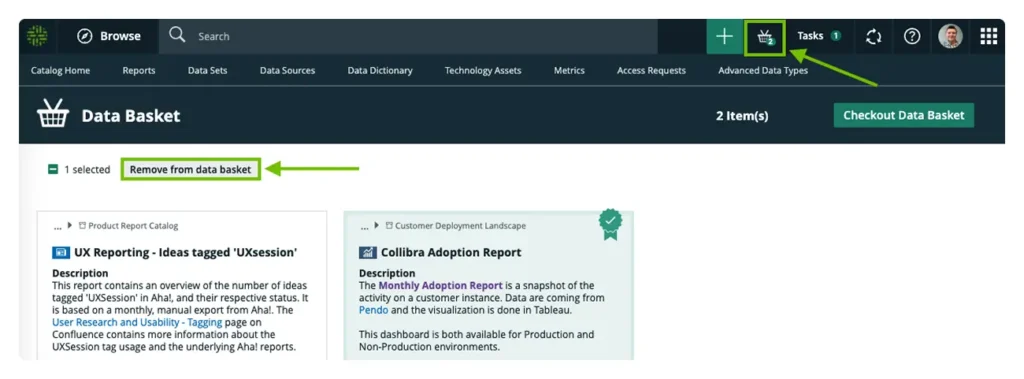You already know your organization needs a data marketplace – but how do you convince the C-suite? We have years of experience doing that, so here are some helpful pointers and ideas for pitching a Collibra Data Marketplace to your executives and democratizing data access for your teams.
The end of the daily data scavenger hunt
If you’re reading this, you’re probably well aware that many enterprises (maybe yours included) don’t have an efficient and sustainable approach to their data. Data is often scattered across drives, files, and even individual devices. And employees have a hard time a. accessing it and b. trusting that what they finally accessed is reliable. Is it really the latest version? And if not, who knows which one is?
And while teams scramble to locate and access trustworthy data, C-level executives are often oblivious to the problem. Even though they themselves might be making strategic decisions based on data of dubious quality.
The underlying issue is not just where the data lives, but also how people find, understand, and access it. Right now, your organization’s “data shopping experience” might be like wandering through a chaotic street market, with absolutely no guarantee of data quality.
The question is, how do you effectively alert your C-suite to the issue and gain their buy-in to invest in the tools that can easily solve it? Tools like a Collibra Data Marketplace that let users shop for trusted datasets and confidently make data-driven decisions.
Well, you definitely need compelling facts and figures. So, let’s take a look at some of them and how to use them to build your pitch.
Step one: Explain the problem – how data chaos is silently costing the business
For the sake of the C-suite argument, let’s think of it as a tax the business is inevitably paying, always at the expense of its profits. There are at least three types you can use to build your argument:
The compliance & security tax
When data is emailed around in unsecured spreadsheets, often without any audit trail, it’s a recipe for a compliance disaster.
It’s both a financial and reputational risk. A single GDPR violation could cost the business millions in fines. And the permanent damage to customer trust that comes with it might cost you even more.
The wasted productivity tax
Your highly paid analysts spend more time looking for data than analyzing it. That’s a common operational efficiency problem – one that’s easily avoided. Every extra hour spent hunting for the right dataset inflates project costs and erodes team morale. Over time, it burns out your best talent and delays key projects.
The flawed decision tax
Different teams across the company use different, often unverified datasets. And that leads to conflicting reports and endless debates over “which numbers are right.”
This one’s a strategic risk. Leaders are making decisions with a compass that’s not really working. And this usually leads to failed campaigns, missed revenue targets, and lost competitive edge.
Step 2: Explain the solution – an easy, organized way to access data across the enterprise
You can even use the analogy of a massive online store, but for data, where data products are organized, each one has a description, ratings, and reviews from other customers. You can filter, compare, and check out in seconds, and the whole process is secure and tracked.
That’s essentially what a data marketplace is for your business.
- Findable products: Every dataset has a clear, standardized name and belongs to a logical “aisle”, so users know exactly where to look.
- Trusted reviews: Each asset page shows rich context: source, owner, quality score, and user feedback. Teams know which datasets to trust without having to guess.
- Secure “checkout”: Access requests are quick, governed, and fully auditable. So there’s no more emailing around sensitive files.
In business terms, this model tackles all three problems we mentioned when talking about the “tax”:
- Efficiency: Finding the right dataset takes seconds, not days.
- Trust: Clear documentation and feedback eliminate uncertainty.
- Security: Every access is governed and tracked, so nothing goes under the radar.
Step three: Talk about the technicalities of implementing a data marketplace
Explain how the features of a Collibra Data Marketplace help turn an existing (sometimes still messy) data catalog into a clean, user-friendly shopping experience for business users, facilitating company-wide access to trusted data.
Note: It’s not a new database
This is important to clarify: the Marketplace doesn’t store the data itself. It’s a curated catalog of pointers that help people find and access the data where it lives, whether that’s in a data lake, warehouse, or external system.
Key data marketplace features and what they mean for you
- Intuitive search & discovery
Users can access data through a self-serve interface, reducing the ad-hoc data ticket load for your team. The interface is designed for business users, not just data experts.

(1. Title, 2. Introduction, 3. Search, 4. Quick links, 5. Cards, 6. Actions, 7. Go to search)
- Rich asset pages
Every dataset comes with detailed metadata: owner, lineage, quality scores, usage guidelines. This builds automatic trust without someone having to “vouch” for it manually. (And it’s just like a nutrition label on your product.)

- Data shopping basket and governed workflows
Instead of random access requests via emails, users add datasets to a “basket” and submit them for approval. The workflow is automated, with a complete audit trail.

- Ratings, reviews, and collaboration
The community can rate datasets and leave comments. This kind of a feedback loop helps identify the best assets and continuously improve them.
Step four: Show examples of successful case studies
Here’s one from a successful implementation of a custom Collibra Data Catalog for one of our clients, a global life science company – one of the dozens of data catalogs we’ve built so far.
The challenge was – as usual – disconnected data and complicated access to it. Our client’s HR department initiated the project because they needed a consistent way to access or request data. But the interest quickly expanded – it’s rarely just one department that needs data democratization.
With the help of two Collibra experts for hire from Murdio – a Solution Architect and a Workflow Developer – the company built a single marketplace to easily discover and request data and enable broad, secure data sharing in the company.
Among other things, Murdio experts:
- Designed a business-aligned metamodel in Collibra
- Defined asset types, relationships, attributes
- Built a multi-step Access Request process
- Created configurable approvals + integration-ready provisioning
- Delivered full documentation & knowledge transfer
And the result?
A data marketplace ready to scale, with transparent, consistent access to data and a unified discovery experience.
For more, read the full Collibra data marketplace case study.
Step five: Frame the argument, speaking your executive’s language
Different executives care about different angles and different business areas. And your pitch needs to land with each one. So, here are some ideas to talk about for a compelling data marketplace pitch.
The pitch to the CFO
What to focus on: ROI, cost reduction, risk mitigation.
How to frame the conversation:
- We can cut wasted analyst time and reduce operational costs by automating manual data tasks.
- We mitigate the risk of multi-million-euro compliance fines by creating a single, defensible audit trail for every data access.
The pitch to the CRO / CMO
What to focus on: Speed, agility, competitive advantage.
How to frame the conversation:
- We can launch data-driven campaigns in weeks instead of months.
- Teams can self-serve trusted customer data to react faster to market changes and uncover insights before competitors.
The pitch to the CCO / General Counsel
What to focus on: Security, control, defensibility.
How to frame the conversation:
- We get a centralized control panel for data access.
- We can enforce data policies proactively and provide a complete log of who accessed what data and why.
- We can make audits painless and defensible.
Your winning analogy
“Right now, we’re running a multi-million-euro data operation like a corner shop. Or actually, multiple corner shops, each with a different owner.
A data marketplace will turn it into a modern, efficient supermarket chain, ready to grow and profit from all the data it has at its disposal.”
Step six: Explain the process using this quick-start guide to launching the data marketplace
When executives are on board (and according to Collibra, 41% of executives already see substandard data as a top improvement need), here’s the simple, phased roadmap to implementation.
Phase 1: Foundation and strategy (aka the blueprint)
- Pick one problem and one team. Choose a single, high-impact use case as your pilot.
- Build your cross-functional team. Include a business sponsor, a data steward, and a tech lead.
- Define success metrics. Example: “Reduce data request tickets from the pilot team by 75%.”
Phase 2: Curation and content (aka stocking the shelves)
- Identify 5-10 critical datasets for your pilot team.
- Certify these assets – clean, documented, marked as “official.”
(You can read more about data certification in another article about data quality metrics.)
- Pro tip: First impressions matter. Make your pilot assets perfect.
Phase 3: Governance and rollout (aka opening the doors)
- Design a simple access workflow. Keep it fast and avoid bottlenecks.
- Train your pilot team on exactly how it solves their problem.
- Launch and create a feedback channel.
Phase 4: Operate and evolve (aka growing the business)
- Monitor usage and track metrics. See where the value is happening.
- Promote success stories. Use testimonials from your pilot to win over other teams.
- Continuously expand. Add new, curated assets based on demand.
And here’s a downloadable version you can keep handy for when you’re finally launching your marketplace.
Your quick-start guide to launching Collibra Data Marketplace
Phase 1: Foundation & Strategy
☐ Pick 1 problem, 1 pilot team.
☐ Build cross-functional team (sponsor, steward, tech lead).
☐ Define success metrics.
Phase 2: Curation & Content
☐ Identify 5–10 key datasets for pilot.
☐ Certify + document them.
☐ Make them perfect — first impressions matter.
Phase 3: Governance & Rollout
☐ Design simple, fast access workflow.
☐ Train pilot team on solving their problem.
☐ Launch + open feedback channel.
Phase 4: Operate & Evolve
☐ Monitor usage + track metrics.
☐ Share success stories.
☐ Expand curated assets based on demand.

The bottom line
Beyond being frustrating, the daily data scavenger hunt is also expensive and risky. And probably holding your business back. (We also talk about how in our article on Collibra Data Quality, if you need even more ideas to take to your C-suite.) And Collibra Data Marketplace offers a clear, proven path to turn chaos into clarity.
For executives, the value is obvious once you speak their language: reduced costs, faster decision-making, airtight compliance. For you as a data manager, it’s the tool that shifts you from being a bottleneck to being a strategic enabler. (And finally shedding the frustration that comes with being the former.)
And if you need any help discussing your business case or implementing the data marketplace, call Murdio experts, and we’ll help.
FAQ
Is Collibra Data Marketplace another place to store data?
No, Collibra Data Marketplace is not a database. It’s a storefront that points to your existing data sources, with context and governance built in.
Will a Collibra Data Marketplace slow down data access with extra steps?
No, if set up well, it actually speeds things up by automating approvals and letting users self-serve trusted datasets.
How do we build a Data Marketplace in Collibra?
You can launch an out-of-the-box Data Marketplace, which includes scope, filters, actions, landing page data, and search suggestions. Make sure that you have it enabled and that you have the required permissions.
And if you need a more customized Data Marketplace, better call Murdio!
Share this article
Related Articles
See all-

15 November 2025
| Collibra experts for hireWhat is Collibra Edge? A 2025 Explainer
-

15 November 2025
| Collibra experts for hireThe definitive guide to Collibra Data Lineage
-

3 November 2025
| Collibra experts for hireCase Study: Discovering, classifying and cataloging unstructured data for a European bank



